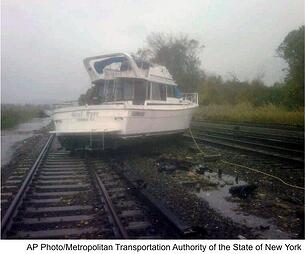Hurricane Sandy has petered out, but the destruction left in her wake is massive. New York and New Jersey have both sustained extensive damage but in different ways.
In New York, the city’s infrastructure has been especially hard hit with the Holland and Brooklyn Battery Tunnels flooded. Mass transit received an especially heavy blow when the subway system was swamped with floodwaters.[1] Authorities are not sure how long it may take to clear out the flooding, let alone repair all the damage.
Internet connections were compromised and even back-up generators failed.[2] Parts of the city are still without water and power as of this writing, Wednesday night, Halloween. However, life is flickering back (just like the street lamps) in Manhattan and Brooklyn.
 The New York Stock exchange opened its doors for business again after being closed for two days. Some airports were able to resume limited arrival and departure flights. And the-show-must-go-on mentality was in evidence as Broadway theatres scheduled matinees and nighttime performances.
The New York Stock exchange opened its doors for business again after being closed for two days. Some airports were able to resume limited arrival and departure flights. And the-show-must-go-on mentality was in evidence as Broadway theatres scheduled matinees and nighttime performances.
Unlike New York, life is nowhere near getting back to normal for many residents of New Jersey. The destruction in New York seems to have hit businesses and the financial district as well as high-rise homes. In New Jersey the worst damage was to seaside neighborhoods.
On the shores where Hurricane Sandy first made landfall, beach front residences were hit hard and many people are now homeless or their homes have sustained such damage that they are forced to take shelter elsewhere.
The National Guard has been dispatched to provide food and shelter to storm victims. Fires burned which firemen were unable to fight because of flooding.[3] Historic boardwalks and islands were especially devastated by the pounding waves and vessels were tossed ashore, sometimes ending up in backyards or slammed into homes.[4]
In the commercial sector, New York and New Jersey ports have sustained major damage and it is unsure when they will resume operating.[5] Power outages are also hindering reopening the ports. Even were they to open, extensive damage to the surface transport infrastructure hinders commerce. Roads, trains, and subways are choked with debris and standing water. It will likely be several days before the damage is repaired and business as usual may resume.[6]
Some shipping containers were displaced by the storm and are floating free in the floodwaters as well as in the channel. Authorities are anticipating water damage to the contents of these containers. Hopefully, their shippers purchased cargo insurance.
There is the chance that some shipping containers have been submerged. The channel is being searched by the Coast Guard for underwater obstructions before it is declared clear. Only after the channel is declared safe can import and export commerce resume in these key northeastern ports.[7]
As a result of the disarray at the hard-hit New York and New Jersey ports, cargo ships bound for NY/NJ ports are being redirected to other locations such as Norfolk. Many other harbors on the Atlantic coast have recovered from lesser storm damage and have reopened, such as ports at Virginia and Baltimore, and are providing alternate docking sites to ships stranded at sea, unable to berth at NJ and NY ports.
Roads have been the quickest surface transport infrastructure to be restored, but many roads to hard hit areas are closed to all but emergency traffic. Several bridges, such as the Tappan Zee, which were closed in anticipation of Hurricane Sandy’s arrival, have recently been re-opened and essential goods are starting to make it to where they are most needed. [8] Transport of commercial goods will begin next but not until the need for relief supplies has been ameliorated.
What can we do to best assist those in need at this time? What can you do to prepare now for natural disasters common to the area you live in? Respond in our comments section below.
